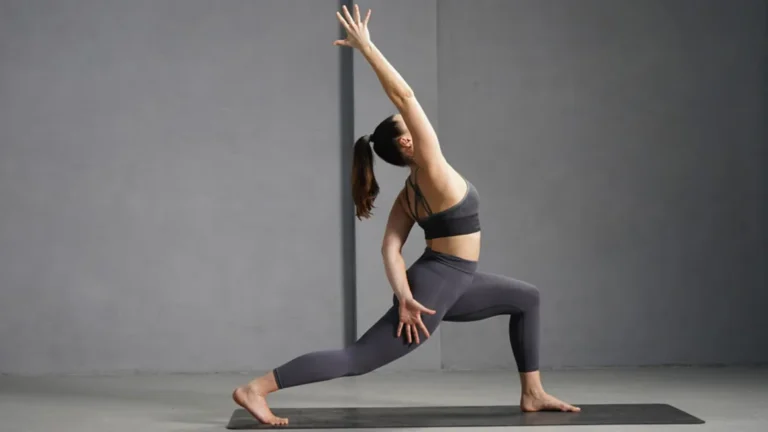
To perform precise, elegant movements, dancers need to possess extraordinary control and flexibility. Yoga can greatly improve a dancer’s flexibility and body control, even though regular dance practice sharpens these abilities. Yoga positions emphasize using breathwork and balance to lengthen muscles, increase the range of motion, and promote better awareness of the body.
Dancers may concentrate on areas that require more mobility and improve the muscles that allow for smooth, controlled movement by practicing particular positions like Pigeon Pose, Tree Pose, and Downward-Facing Dog. Whether it’s for deep lunges, high leg extensions, or seamless transitions, yoga provides dancers with an effective means to hone their skills, lower their risk of injury, and improve their performance all around. Therefore, in this piece of writing, we’ll describe which yoga poses enhance flexibility & control for dancers. So, stay with us here and keep reading below.
Top 7 Yoga Poses Enhance Flexibility & Control for Dancers
To execute intricate routines with grace and accuracy, dancers need to have strong body control and flexibility. Although many of these qualities are developed through dance instruction, yoga can be used as a supplemental exercise to increase control and flexibility. Yoga’s slow, methodical poses and emphasis on breathing can help dancers establish a stronger connection with their bodies, which will improve the fluidity of each action. Therefore, in this article, we’ll cover the top 7 yoga poses to enhance flexibility & control for dancers. So, dig deeper into this article to reveal the notion.
1. Downward-Facing Dog
One of the most adaptable yoga poses, the downward-facing dog is a mainstay of many yoga regimens. This pose is great for strengthening and lengthening the calves, hamstrings, and spine in dancers. Dancers can increase flexibility in their back and legs and release tension in their lower bodies by raising their hips and pressing their heels towards the floor. In addition to fostering control, the emphasis on anchoring the hands and feet encourages dancers to sustain their balance by using their cores to retain the stance.
2. Low Lunge
Dancers need to have a lot of hip flexor flexibility, especially when it comes to high kicks, splits, and deep lunges. By extending the quadriceps and hip flexors, the Low Lunge lengthens the front of the leg and opens up the hips. By using their core and keeping their balance while elevating their arms aloft, dancers can gain control in this stance.
Regular practice of low lunge pose, you can enhance the flow of certain dance forms’ characteristic deep lunges and leg extensions. Therefore, most people enroll their self at Hot Yoga Dubai Downtown to add an effective asana in their lives that boosts endurance.
3. Pigeon Pose
A deep hip opener that works the hamstrings, piriformis, and hip flexors is the pigeon pose. Due to their practice’s physical demands and repetitious movements, many dancers have tightness in these areas.
Pigeon Pose increases hip flexibility and promotes body awareness and mental attention, two things that are necessary for choreographic mastery. Regular practice of this pose can help dancers lower their risk of injury and improve their hip range of motion, which facilitates more controlled and seamless transitions between moves.
4. Cobra Pose
To do backbends or any other dance move that calls for an arched spine, dancers should practice a cobra pose as it greatly enhances back strength and flexibility. By pressing both hands into the mat and raising their chest off the floor, dancers expand up their chest and create a deep spinal stretch.
To help dancers execute controlled back stretches and maintain proper posture throughout their routines, this pose develops the muscles in the lower back. Opening the chest in Cobra Pose also expands lung capacity, which can help with respiratory control during performances.
5. Standing Forward Bend
Another great pose for increasing lower back and hamstring flexibility is the standing forward bend. This stance helps dancers extend their range of motion for leaps, jumps, and kicks by allowing an extended stretch along the full back of the legs.
Additionally, the stance helps dancers release upper body tension, which promotes relaxation and breath control. Maintaining extended holds in Uttanasana can also help with balance and mental attention, two things that are necessary for accurately performing intricate dance routines.
6. Bridge Pose
Bridge Pose opens the shoulders and chest while strengthening the back, glutes, and hamstrings. This pose is particularly beneficial to dancers because it strengthens the muscles required for regulated backbends and arching motions.
Additionally, it increases the flexibility of the spine and relieves lower back stress that builds up with frequent hops and spins. Dancers can enhance their body control by using their glutes and core in this stance, which will result in more balanced and seamless transitions.
7. Tree Pose
An essential component of dancing is balance, and Tree Pose is a great way to practice this. When performing a tree pose, performers stand on one leg and place the inner thigh or calf of the other foot on the ground. Dancers must use their core to stay balanced in this stance, which tests their stability.
Dancers can become more precise in their arabesques, pirouettes, and other balancing routines by practicing Tree Pose, which gradually improves control in one-legged strokes and turns. Moreover, it increases ankle stability and lowers the risk of injury. For this, you can join yoga classes to get the assistance of experts in performing the appropriate asanas.
Are You Ready to Adopt Effective Yoga Poses?
For dancers, yoga positions are a great approach to increase body control, strength, and flexibility. Pose variations like Tree Pose, Pigeon Pose, and Downward-Facing Dog can assist dancers develop more agility and control in their routines. Yoga encourages mental focus, breathing control, and awareness of your body, all of which are critical for optimal performance and enhance not just the physical components of dancing. Dancers can stretch their artistic boundaries and achieve new heights via the regular practice of these stances.
Read more: Yoga for good Health